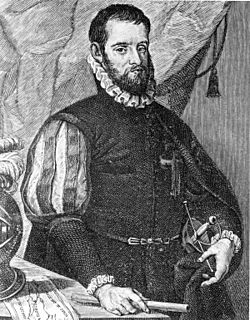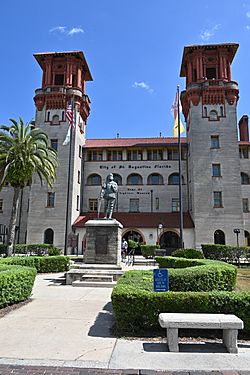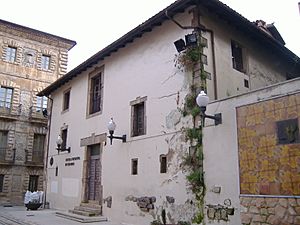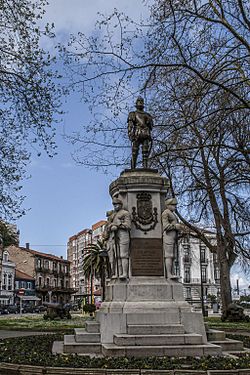Pedro Menéndez de Avilés facts for kids
Quick facts for kids
Pedro Menéndez de Avilés
|
|
|---|---|

Pedro Menéndez de Avilés
|
|
| 1st Governor of Florida | |
| In office 1565–1574 |
|
| Succeeded by | Diego de Velasco |
| Personal details | |
| Born | 15 February 1519 Avilés, Asturias, Spain |
| Died | 17 September 1574 (aged 55) Santander, Cantabria, Spain |
| Occupation | Admiral; 16th-century colonial governor of La Florida and Cuba, in New Spain |
Pedro Menéndez de Avilés (born February 15, 1519; died September 17, 1574) was a Spanish admiral and explorer from Avilés, Spain. He is famous for two major achievements. First, he planned the convoys for the Spanish treasure fleet, which were groups of ships that carried riches from the Americas to Spain. Second, he founded the city of St. Augustine, Florida, in 1565.
St. Augustine was the first permanent European settlement in what is now the continental United States. It remains the oldest city in the U.S. that has been lived in continuously since it was founded by Europeans. Menéndez became the first governor of La Florida (the Spanish name for Florida). He was given the title of adelantado by the king of Spain, which gave him the power to explore and govern the new territory.
Contents
Early Life and First Adventures
Pedro Menéndez de Avilés was born into a noble family in Asturias, a region in northern Spain. He was one of twenty children. When he was young, his father passed away, and he was sent to live with a relative.
Pedro had an adventurous spirit and did not get along with his guardian, so he ran away from home. After being found, he decided to join the military. He began his career at sea, fighting against French pirates, known as corsairs, who were attacking Spanish trading ships.
After a few years, Menéndez used his own money to build a small, fast ship called a patache. He and some of his relatives sailed it to protect the coast. He quickly became known as a skilled captain. In one famous battle, he defeated French corsairs who were attacking Spanish ships, capturing two of their vessels. His bravery and skill earned him a great reputation in Spain.
A Career at Sea
Protecting the Treasure Fleets
Menéndez's skills caught the attention of the Spanish king. In 1554, he was made Captain-General of the Fleet of the Indies, also known as the Spanish treasure fleet. This was a very important job. The treasure fleet was a group of ships that sailed together to carry gold, silver, and other valuable goods from the Americas back to Spain.
His main task was to make sure these ships were safe from pirates and storms. He designed a new system of convoys, where strong warships sailed alongside the cargo ships to protect them. He also helped design new, powerful ships called galleons that were perfect for these long, dangerous journeys. Menéndez successfully led the fleet many times, making the sea route between Spain and its territories much safer.
A Trusted Royal Officer
King Philip II trusted Menéndez and they worked closely together. The king even invited him to England for his wedding to Queen Mary I.
Because of his success, the king gave Menéndez the title of adelantado of La Florida. This meant he was in charge of exploring the vast territory, which at the time stretched from Florida all the way up to Canada. His mission was to build forts, bring settlers from Spain, and establish Spanish rule in the area.
The Founding of Florida
A Mission from the King
In the 1560s, Spain learned that France was trying to claim land in Florida. A group of French Protestants, called Huguenots, led by Jean Ribault, had built a settlement called Charlesfort in what is now South Carolina. A few years later, another French group built Fort Caroline near modern-day Jacksonville, Florida.
King Philip II was worried because these French forts were close to the route used by the Spanish treasure fleets. He ordered Menéndez to go to Florida, remove the French, and build Spanish settlements to secure the land for Spain. At the same time, Menéndez was also hoping to find his son, Juan, whose ship had been lost in a hurricane near Florida.
Arrival and Founding St. Augustine

Menéndez set sail from Spain on July 28, 1565, with a fleet of ships carrying over 1,000 soldiers and settlers. On August 28, the feast day of St. Augustine, his ships spotted the coast of Florida. He decided to name the future settlement in honor of the saint.
On September 6, Menéndez and his people landed. They quickly began building a fort to protect themselves and their supplies. This settlement became the city of St. Augustine, the first permanent European town in the United States.
Conflict with the French
After establishing St. Augustine, Menéndez turned his attention to the French at Fort Caroline. He led his soldiers on a surprise march through swamps and forests. On September 20, 1565, the Spanish attacked the fort. Many of the French soldiers died in the battle, and the Spanish took control of the fort, renaming it San Mateo.
Meanwhile, the French leader, Jean Ribault, had sailed to attack St. Augustine. However, a powerful storm wrecked his ships along the coast. Menéndez found the shipwrecked French survivors in two groups near an inlet. After they surrendered, Menéndez, following the harsh rules of war at the time, ordered that they be executed. The inlet where this happened is now called the Matanzas River, which means "slaughters" in Spanish. With the French defeated, Spain had full control over the Florida coast.
Governor of La Florida
Exploring the Land
As governor, Menéndez worked to strengthen Spain's control over Florida. He built more forts and sent out expeditions to explore the land. One famous expedition was led by Captain Juan Pardo, who traveled deep into the interior of what is now South Carolina and Tennessee. Pardo's group built several forts, but they were later destroyed by Native Americans who resisted the Spanish presence.
Menéndez believed Florida was strategically important. He hoped to find a water route through the continent to Mexico or even China, but this passage did not exist.
Encounters with Native Tribes
Menéndez traveled throughout Florida and met with many Native American tribes. He tried to make peace with some groups, like the Calusa tribe in southwest Florida. To create an alliance, he even married the sister of the Calusa leader, who was named Carlos. However, the peace between the Spanish and the Calusa did not last.
He also met with the Tequesta tribe near modern-day Miami and the Timucua tribe near St. Augustine. He brought Jesuit missionaries to teach the Native Americans about Christianity, but these efforts were not very successful at the time. Relations with many tribes remained difficult, and conflicts continued for many years.
Final Years and Legacy
In 1567, Menéndez returned to Spain to report to the king. He was also appointed governor of Cuba. He traveled across the Atlantic Ocean several more times to manage the new colonies.
His last trip to Florida was in 1571. Shortly after, he fell ill while in Spain and died of typhus on September 17, 1574.
Pedro Menéndez de Avilés is remembered today as a key figure in the early history of the Americas. His founding of St. Augustine created a permanent Spanish presence in North America. His legacy is honored in Florida, where a high school and streets are named after him. A World War II ship, the SS Pedro Menendez, was also named in his honor, and a new frigate for the Spanish Armada is named for him.
See also
 In Spanish: Pedro Menéndez de Avilés para niños
In Spanish: Pedro Menéndez de Avilés para niños
- El Portal, Florida
- History of Florida
- Roman Catholic Diocese of St. Augustine
- St. Augustine, Florida
- Spanish Florida



